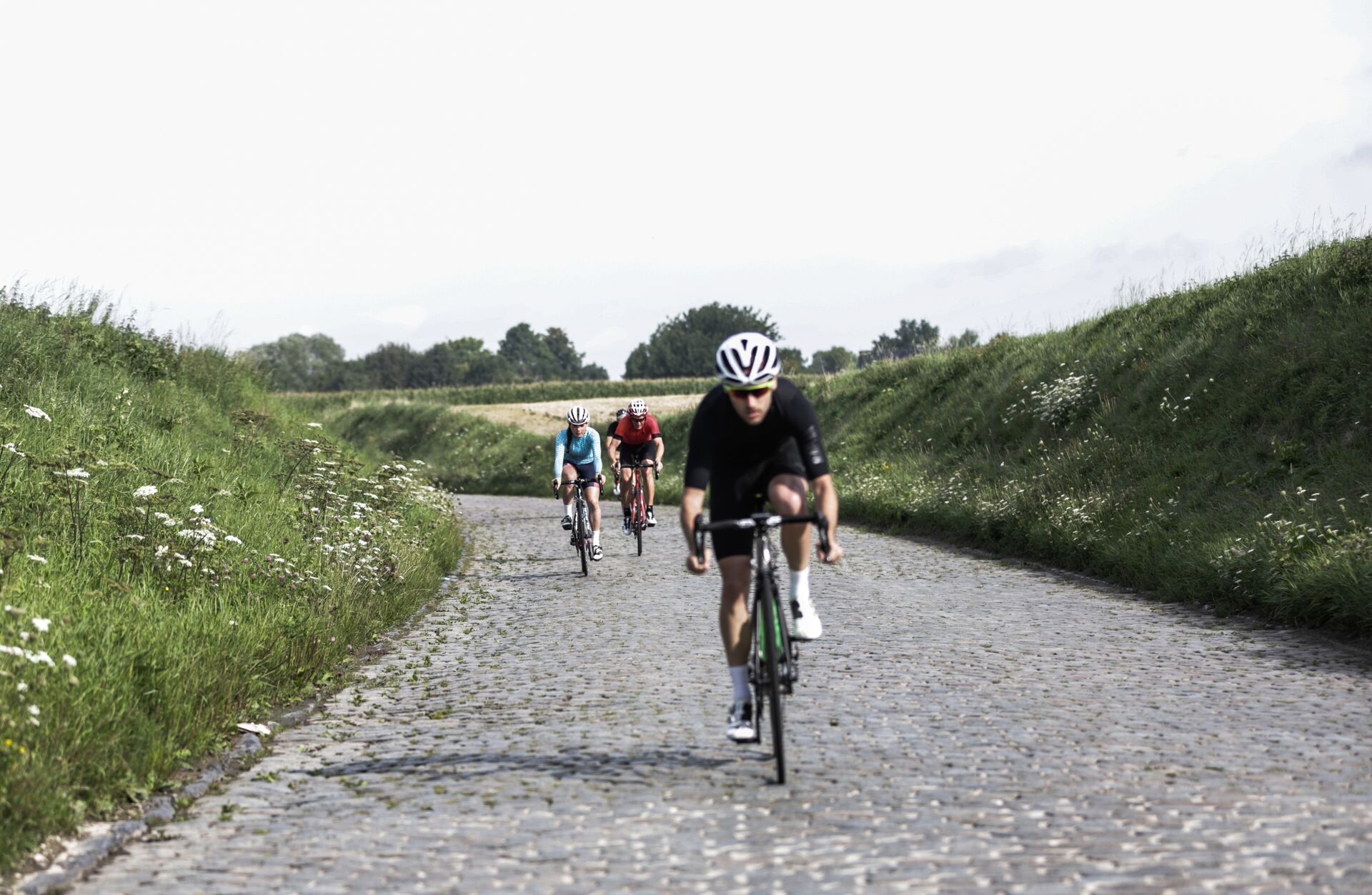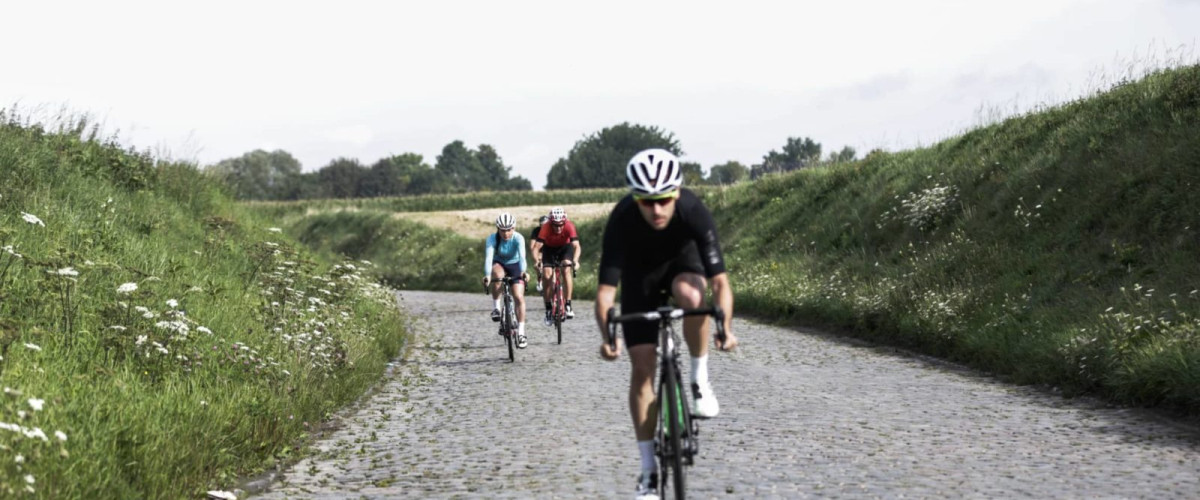The route step by step
Start
Cobbles, cobbles & more cobbles
The last climb of Dwars Door Vlaanderen and the finale of Nokerekoerse: the only option here is to put the pedal to the metal and forge on ahead: a 350 m stretch, with an average gradient of 5.7% and the steepest incline at 7%, it was here that a touch of wheels in the sprint led to a huge crash for Mathieu Van Der Poel in the 2019 Nokerekoerse.
A 1450m long cobble section located in Wannegem-Lede and recognized by its windmill, dating to 1783. It was banned from the Ronde in 2008 when it fell into disrepair (although the organisers of the Sportif event had no such qualms in sending amateurs over it!) but now it's been cleaned up and makes for one of the best cobbled rides in the area. The open, flat section after the village is fast, with the wind normally behind you, and gives a great view of the surrounding country down to the Schelde.
Be aware that from August 2023 untill March 2024, road works are taking place at the Doorn segment. Just try to walk through the section. If that didn't work, show us your Strava activities and how many segments you completed, and we'll make sure you're registered as a finisher.
A 1.620 m long, narrow and oldschool stretch of cobblestones Doorn is the Flemish answer to the untamed cobbles of Paris-Roubaix. It's name actually means 'thorn' and it will hurt with the paved road afterwards feeling like heaven.
A short cobblestone road runs straight through the adorable village of Mullem and leads you to foot of Den Ast. At the end of this slope you will find the castle of the Gerlache family, which is locally called the ‘Ter Ast’ castle. This climb has been used 5 times in the Ronde (1997-2000, 2010). A climb for the big ring.
The 2.260 meter long cobblestone road ‘Paddestraat’ is Flanders’ most well-known cyclist’s ‘scourge’. This present day bone rattler was once part of a Roman ‘Via’ between Boulogne-sur-Mer and Cologne. The Paddestraat became a well-deserved national monument in 1995. Here you will find the ‘Ronde van Vlaanderen Monument’, which lists the names of all Ronde winners since 1973, the year in which the Paddestraat was added to the parcours. The right hand bend after the railway crossing where you enter the cobbles was where Frank Vandenbroucke lost his bid for glory in 1999 after a brave attack with 150km to go in the company of teammate Philippe Gaumont. "Fresh" from a night out in Bruges that lasted until the early hours, Gaumont slid out on the bend and broke his wrist. VDB still managed to take second in the sprint.
Some history
Paddestraat is a remnant of an old Roman road that joined the French Bavay with the East-Flemish Velzeke. And the fact that there are still cobblestones here can be attributed to a few fans of the Tour who fought in the 1990s to have them officially listed as part of Flemish heritage. The Paddestraat has been part of the Tour of Flanders since 1973, with the only exceptions being in 1988 (due to road works) and 2011 (due to a change of route).
Indeed, there is a monument here that lists all the winners of the Ronde who have ridden down Paddestraat. Next to the year 2011, you can read in fine print: 'Paddestraat forgotten'.
The Molenberg was for a long time the first pivot point in the Ronde. Indeed, much hinged on the poor state of the cobblestones and the bottleneck that ensured when the peloton attacked the Molenberg. Two-time winner Peter Van Petegem always said: “If you’re not in the first 10 to take the Molenberg, it will take you at least half an hour to get back in front.” The Molenberg was also the place where Tom Boonen and Fabian Cancellara broke away from the pack in 2010. On that occasion, Cancellara went on to win the Tour of Flanders. This is a climb you want to hit hard.
The Jagerij is a 730m long cobble section that lies just outside Oudenaarde. The stones are regular and well set, which means a comparatively smooth ride across them before a fast descent down to the Smarre before you take on the Molenberg.
2.550 meters of gently rising cobbles. The cobbles are not that nasty as their neighbouring sections but the grade of 3% will definitely hurt. This stretch is remembered for a moment in the 2015 Tour of Flanders where almost the entire favourites group took to the pavement amongst the spectators, except Ian Stannard who ploughed on through the middle of the cobble, oblivious. Attention Flandrien Challenge hunters: the markings on the road are currently wrong, but the Strava segment as integrated in our route is correct.
Halfway along the Kerkgate is the cafe of De Witte Hoeve, which is one of the liveliest places to spectate Omloop Het Nieuwsblad, with the race passing twice and team staff handing up bidons on the pavement outside. Sometimes soigneurs can be seen sneaking a quick beer between passages.
The Wolvenberg in Oudenaarde is 660 m long and features an average incline of 7.9 %, with a stretch at 17.3 %. You can sprint up this hill, but you'll pay for it at the top when you either go straight onto the cobbles of the Ruiterstraat or turn right onto those of the Holleweg.
600 meters of moderate cobbles and one of the most fun segments to ride, the little downhill once you make the right turn will give you speed enough to cruise to the end, feeling like Tom Boonen, if you can keep your gear turning.
Finish

Plan your stay
Get the hottest tips and tricks to take on Flanders by bike! When should you visit? Where can you rent a bike? What's the perfect place to stay? Or drink the perfect Belgian beer? Check it out!
Related bucketlists
Epic Stories
Those who adore cycling are bound to collect some great stories. Here they are, or at least some of them.
